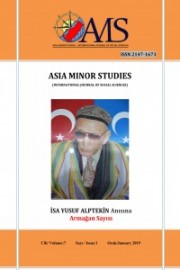OSMANLI ARŞİV BELGELERİNE GÖRE MUŞ’TA ERMENİ İHTİLALCİLERİN ERMENİLERE ZULMÜ (1892-1906)
ACCORDING TO OTTOMAN ARCHIVE DOCUMENTS PERSECUTIONS OF ARMENIAN REVOLUTIONARIES AGAINST ARMENIANS IN MUSH (1892-1906)
Author(s): Mustafa Çabuk, Semra TombulSubject(s): Diplomatic history, Military history, 19th Century, The Ottoman Empire
Published by: Kilis 7 Aralık Üniversity
Keywords: Ottoman; Mush Sanjak; Armenian Committee; Rebellion;
Summary/Abstract: The 1877-1878 war, known as 93 war between the Ottoman Empire and Russia was ended with the defeat of the Ottoman Empire. After that war the Treaty of Berlin was signed. The European states put a clause into the Berlin Treaty related to the Armenian nation living in the Ottoman geography. Thus, the Armenian question became an international problem. It was used as an excuse by the great states to intervene in the internal affairs of the Ottoman State. After this date, the Armenians increased their revolt and revolutions against the Ottoman State. European States supported these uprisings politically, financially and morally. The Armenians had dreamed that as a result of these uprisings, European states would send military troops to the Ottoman State and with the help of these powers an independent Armenian state would be established. For these aims, the Armenians started to organize committees for the rebellion against the Ottoman State. One of the places where the Armenian revolution committees were active was Sanjak of Mush which was belonging to Bitlis Province. In Sanjak of Mush, the Armenian revolutionaries first started their rebellion with economic excuses in 1885. There was a big rebellion in Sanjak of Mush and Town of Sason in 1894. In these periods, great massacres were carried out by the Armenian revolutionaries in the Sanjak of Mush and its environment. Armenian revolutionaries carried out massacres against not only to the Muslim people but also to the Armenians who did not support the rebellion movement and who were loyal to the state in Sanjak center of Mush and its‟ periphery. Armenian rebels burned houses, schools and churches belonging to Armenians in villages that did not support the rebellion. Armenian rebels burned the houses, schools and churches of the Armenians who did not support the rebellion. On the other hand, Armenian revolutionary organizations wanted to accuse the Muslim people of the persecution of the Armenian people. They made propaganda in this direction. However, as a result of the investigation, it was determined that the events were carried out by the members of the Armenian Revolutionary Committee.
Journal: Asia Minor Studies
- Issue Year: 2019
- Issue No: 1
- Page Range: 1-14
- Page Count: 14
- Language: Turkish

